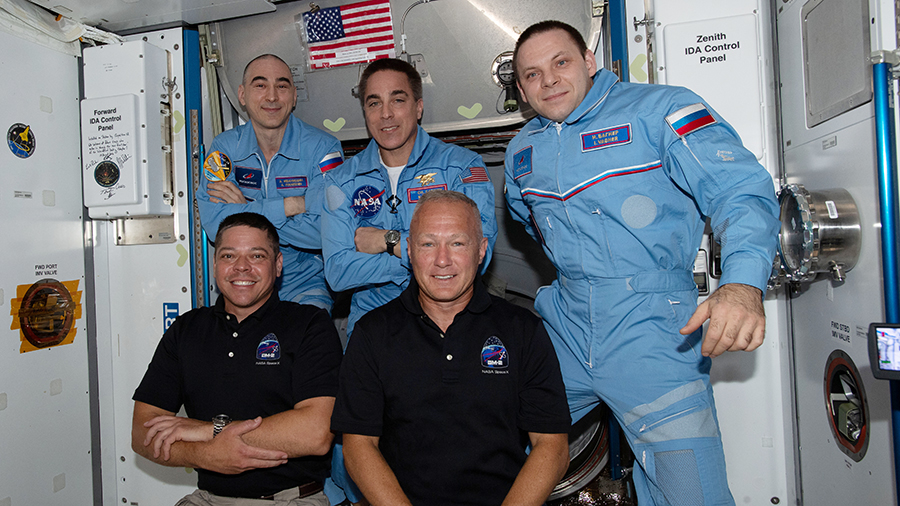
The three NASA astronauts and two Roscosmos cosmonauts that comprise the Expedition 63 crew are keeping the International Space Station humming with space research.
Less than a week into their stay on the orbiting lab, Flight Engineers Doug Hurley and Bob Behnken are still orienting themselves with station systems and operations. Meanwhile, the duo is beginning to step up their advanced science activities to benefit people on and off Earth.
Hurley is getting up to speed with a pair of space physics experiments today. He started research today on space bubbles and microfluids to improve oxygen and medicine delivery systems. He then photographed hardware being set up to research how tiny particles behave in fluids. Results could improve the development of advanced materials and 3D printing techniques.
Behnken is studying how to remove and re-install a plant habitat so he can access and replace life support gear on Thursday. He also tested the SpaceX Crew Dragon’s wi-fi system that connects the spacecraft’s portable computer tablets.
Both astronauts also joined NASA Commander Chris Cassidy on Wednesday afternoon reviewing station safety procedures and equipment. Cassidy spent the morning setting up science gear that Hurley would later use to begin his space bubbles research.
In the Russian segment of the station, cosmonauts Anatoly Ivanishin and Ivan Vagner split their time between Earth observations, radiation checks and module inspections. The duo also videotaped messages and station activities for audiences on the ground.

We are very proud of all of you. How does blood react in space ? Does it coagulate quicker?
Scientists are studying what happens to an astronaut’s blood. The crew often collects their own blood samples, spins them in a centrifuge and stows them in a science freezer for later analysis on Earth. Check out the variety of blood research here… https://go.nasa.gov/2Aa5m8b
Loving the updates. So fascinating. I really enjoy the weekly podcasts too. Keep up the great work guys and hopefully might catch a sighting in the sky soon!
Porque van hacer reemplazar el hábitat de planta, ahí en la estación.
¿ Para que sirve el reemplazo?
They didn’t replace the plant habitat. They temporarily removed it to access life support gear behind the botany research device.
Keep up the great work you are doing. I follow ISS everyday. So proud of the way the countries work together on ISS.
Take care and God Bless
Since the SpaceX Launch last Saturday, I’ve been sharing information about it with my very elderly parents (Dad is a WWII vet) to try and help them focus on something exciting happening and not their confinement in their assisted living community. I have also seen the Space Station go over my house three times since Sunday evening. It’s so exciting and even comforting to see it in the night sky. I appreciate NASA’s instructions on how to look for it.
Hello from Tucson, Arizona!
NICE PICTURE! YOU ALL LOOK GREAT!
When is the next space walk planned, please.
Spacewalk dates have not been announced yet.
Un abrazo grande para todos aquellos hombres y mujeres que hicieron esto pocible y a los astronautas felicidades a todos los que le gustan el aeroespacial
I am proud of all of you. Your work is awesome. I will keep you in my prayers.
Really awesome post good to see our astronauts at work.